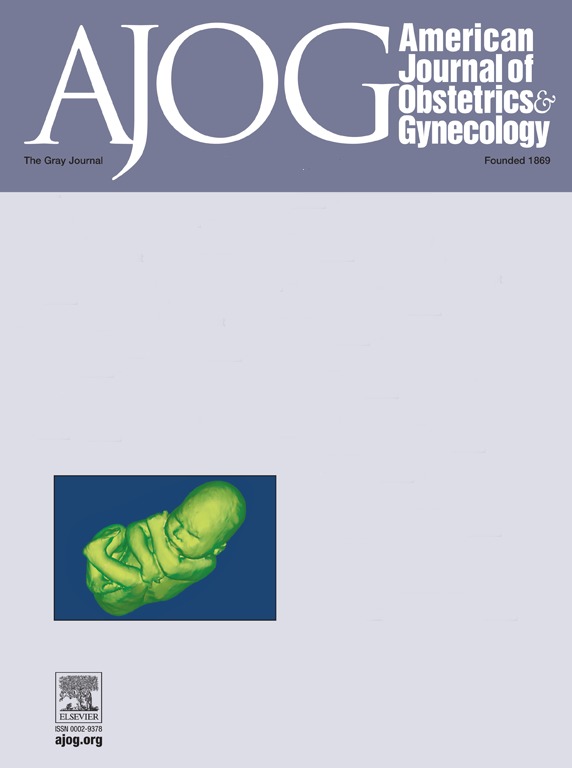Pregnancy outcomes following medical versus surgical treatment of tubal ectopic pregnancy: a population-based retrospective cohort study.
IF 8.7
1区 医学
Q1 OBSTETRICS & GYNECOLOGY
引用次数: 0
Abstract
BACKGROUND Tubal ectopic pregnancy (TEP) is a common cause of maternal morbidity and mortality in the first trimester. Multiple effective treatment options are available for tubal ectopic, including medically with methotrexate, and surgically with salpingectomy or salpingotomy. In general, medical management is preferred because it is thought to be less invasive and less morbid, but long-term fertility and recurrence outcomes between the two management strategies are unclear and inconsistently reported in the literature. OBJECTIVE The current study aims to determine future birth outcomes in patients being treated medically and surgically for tubal ectopic pregnancy. Maternal morbidity including recurrent tubal ectopic pregnancy and treatment complications were also compared. A sub-analysis was conducted between salpingectomy and salpingotomy for the patients treated surgically. STUDY DESIGN This population-based retrospective cohort study used validated, large administrative datasets from Ontario, Canada, a single payer publicly funded healthcare system. Patients were included who were treated for ectopic pregnancy between January 1st 2008 and December 31st 2019 and compared based on type of treatment, medical versus surgical. Baseline characteristics were collected and compared using standardized differences. Multivariable logistic regression was used to determine if there was an association between treatment type and outcomes. RESULTS 17, 090 cases of TEP were reported, 8 204 managed medically, 8 737 managed surgically and 149 receiving both treatments. Patients receiving medical management had a 51.6% future live birth rate, compared to 45.1% with surgical management and a recurrent TEP rate of 7.4% compared to 6.4% respectively. After controlling for baseline characteristics, future live birth rate was higher in the group treated with methotrexate compared to surgically (OR 1.3, CI1.22-1.38, p<0.001). The recurrence rate was also higher in the group treated with methotrexate compared to surgery (OR 1.17 CI 1.04-1.32, p<0.001). The incidence of tubal ectopic pregnancy in Ontario increased during the study period, and with time a larger proportion of patients were treated medically. The medical management failure rate was 15.3%. Overall, healthcare utilization was higher in the group treated with methotrexate. CONCLUSION The present study demonstrates that, for patients with tubal ectopic pregnancy, medical management with methotrexate has potential for increased live birth rate compared to treatment with surgery. This comes at the cost of increased risk of tubal ectopic recurrence, and increased healthcare utilization.输卵管异位妊娠药物治疗与手术治疗后的妊娠结局:一项基于人群的回顾性队列研究
背景:输卵管异位妊娠(TEP)是妊娠早期产妇发病和死亡的常见原因。输卵管异位有多种有效的治疗选择,包括甲氨蝶呤药物治疗和输卵管切除术或输卵管切开术。一般来说,医疗管理是首选,因为它被认为是侵入性较小,发病率较低,但两种管理策略之间的长期生育和复发结果尚不清楚,文献报道也不一致。目的:本研究旨在确定输卵管异位妊娠接受药物和手术治疗的患者未来的分娩结局。并比较了产妇复发性输卵管异位妊娠的发病率及治疗并发症。对手术治疗的患者进行输卵管切除术和输卵管切开术的亚分析。研究设计:这项以人群为基础的回顾性队列研究使用了来自加拿大安大略省的大型管理数据集,这是一个单一付款人公共资助的医疗保健系统。纳入了2008年1月1日至2019年12月31日期间接受异位妊娠治疗的患者,并根据治疗类型进行了比较,内科与外科。收集基线特征并使用标准化差异进行比较。使用多变量逻辑回归来确定治疗类型和结果之间是否存在关联。结果共报告TEP 17 090例,内科治疗8 204例,外科治疗8 737例,综合治疗149例。接受内科治疗的患者未来活产率为51.6%,手术治疗为45.1%,TEP复发率为7.4%,手术治疗为6.4%。在控制基线特征后,甲氨蝶呤治疗组的未来活产率高于手术组(OR为1.3,CI1.22-1.38, p<0.001)。甲氨蝶呤组的复发率也高于手术组(OR 1.17 CI 1.04-1.32, p<0.001)。在研究期间,安大略省输卵管异位妊娠的发生率有所增加,并且随着时间的推移,接受药物治疗的患者比例越来越大。医疗管理失败率为15.3%。总体而言,接受甲氨蝶呤治疗组的医疗保健利用率较高。结论本研究表明,对于输卵管异位妊娠患者,与手术治疗相比,甲氨蝶呤治疗有可能提高活产率。这是以增加输卵管异位复发的风险和增加医疗保健利用为代价的。
本文章由计算机程序翻译,如有差异,请以英文原文为准。
求助全文
约1分钟内获得全文
求助全文
来源期刊
CiteScore
15.90
自引率
7.10%
发文量
2237
审稿时长
47 days
期刊介绍:
The American Journal of Obstetrics and Gynecology, known as "The Gray Journal," covers the entire spectrum of Obstetrics and Gynecology. It aims to publish original research (clinical and translational), reviews, opinions, video clips, podcasts, and interviews that contribute to understanding health and disease and have the potential to impact the practice of women's healthcare.
Focus Areas:
Diagnosis, Treatment, Prediction, and Prevention: The journal focuses on research related to the diagnosis, treatment, prediction, and prevention of obstetrical and gynecological disorders.
Biology of Reproduction: AJOG publishes work on the biology of reproduction, including studies on reproductive physiology and mechanisms of obstetrical and gynecological diseases.
Content Types:
Original Research: Clinical and translational research articles.
Reviews: Comprehensive reviews providing insights into various aspects of obstetrics and gynecology.
Opinions: Perspectives and opinions on important topics in the field.
Multimedia Content: Video clips, podcasts, and interviews.
Peer Review Process:
All submissions undergo a rigorous peer review process to ensure quality and relevance to the field of obstetrics and gynecology.

 求助内容:
求助内容: 应助结果提醒方式:
应助结果提醒方式:


